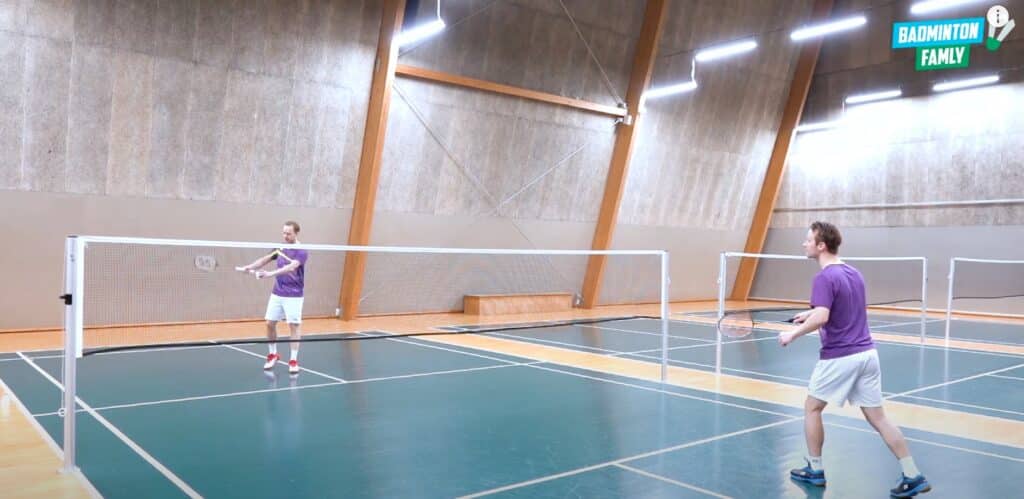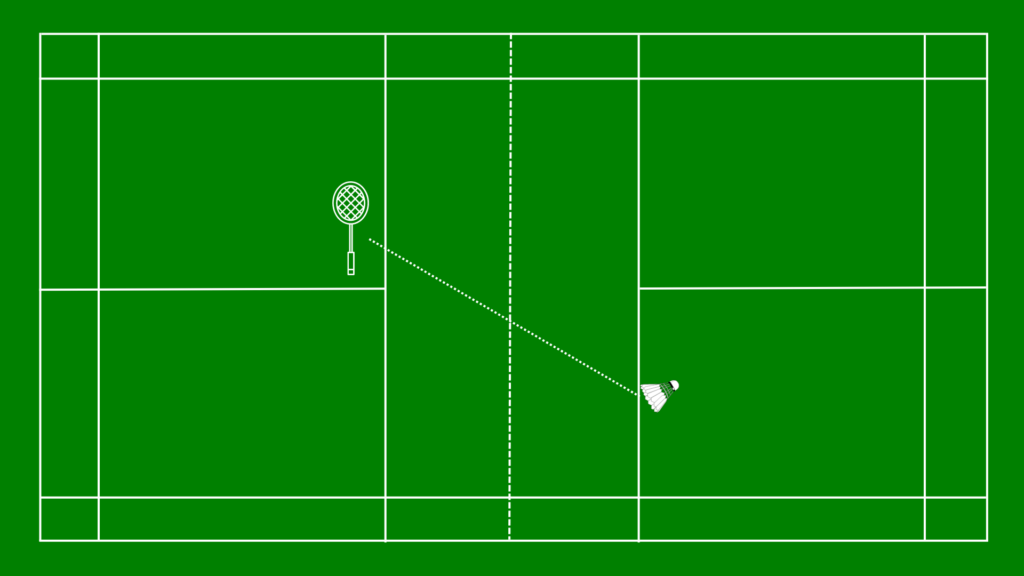The silence of the badminton court is broken by the sound of the shuttle hitting the strings as the racket slices through the air during this badminton low serve.
The shuttle flies over the net, barely skimming the net cord before gracefully descending toward the awaiting opponent. With lightning reflexes, they lunge forward, attempting to return the shot.
But to their surprise, the serve has them scrambling, struggling to regain their balance and find a suitable response.
This is the power of the low serve in badminton—a deceptive weapon that can kill a rally before it has even begun.
Earlier today, I played a game against someone who is skilled at all kinds of different serves. My partner and I barely had any long rallies as most of them never got underway due to our opponent’s powerful serves and variations.
Boring?
You bet.
Effective?
Hell yes!
While this player performed all the different types of serves well, you can begin taking advantage of this yourself with the following two options.
There’s the popular backhand low serve.

Or the less used forehand low serve that can be disguised as a classic forehand high serve.

The backhand low serve is the go-to choice for most players. It offers better control and allows for clever placement, or even surprising your opponents with a flick serve, so that’s the one I’ll focus on in this article.
It also positions you well to quickly respond to a net shot, which tends to be the most dangerous return for us intermediate players.
On the other hand, the forehand low serve is slower and gives your opponent more time to react. It requires a flatter motion, resulting in a longer flight and the need to start further back when serving. In my experience, the forehand low serve is mostly used by older players in casual social games, if used at all.
I was curious about the popularity of these serves, so I analyzed serves from 25 social intermediate doubles games. Out of nearly 900 serves observed, the forehand low serve accounted for just 1.7%, while the backhand low serve dominated with a usage rate of 76%.

I’m not suggesting that we blindly follow the crowd, but there’s a reason why the backhand low serve is preferred. It proves effective in earning a lift or catching opponents off guard, while also allowing for quicker movement towards the net, should your opponent return a net shot.
Speaking of earning points and gaining the upper hand, let’s explore the various goals we can achieve with our serves.
The “forgotten” goal of the low serve
When it comes to casual play, we often treat the serve as just a way to start the rally. We give it a shot, but our main focus may not be on making a strong serve to gain an edge and put pressure on our opponents. It’s only after a few shots that we start taking the rally seriously.
This is one of the major differences between social and tournament play, and presents an opportunity for us to practice our service habits when we’re not playing tournaments. That way, there’s little to adjust when it counts and there’s a higher chance we’ll gain an edge right from the beginning of every rally.
The first goal of the serve is to aim for a direct point and win the rally right off the bat. It’s like scoring a quick win without giving your opponent a chance to react.
But even if we don’t win the point outright, our next objective is to put the opponent under enough pressure that we can seize the rally on the third shot or shortly thereafter. The longer the rally continues, the more we open ourselves up to potential challenges that we might lose.
In doubles games, if we don’t secure an immediate point, the next best outcome is often earning a lift. This sets us up to launch an attack and take control of the rally.
Another outcome that can be in our favor is generating a poor midcourt shot from our opponent that we can attack. But, those can be difficult to plan for and are often a result of luck or mistakes made by our opponents.
The 3 badminton low serve variations and their trade-offs
When performing the low serve, there are three areas to consider. The first one is ‘the T’ (the line splitting the two service boxes and the front service line).

Next is ‘the middle’ (of the front service line)

And finally: ‘out wide’.

If you had to guess which of these three options is the most popular choice among intermediate doubles players, you might guess “the T” – and you would be correct.
My statistics show that it is played 50% of the time, compared to only 22%% for the middle and 4% out wide.
Serving out wide has its advantages. It forces your opponent to cover more distance, increasing the chances of an unbalanced return.
The wide angle often leads to a predictable straight return, which can be advantageous when you’re serving. But it doesn’t come without its downsides.
The shuttle has to travel the longest distance to reach that area, making it easier for opponents to read the serve and intercept it. It can also be challenging to disguise this serve, as it requires turning your body slightly.
On the other hand, the serve in the middle offers a balanced approach between the low serve out wide and the one to the T.
Many players receiving the serve tend to stand near the middle of their service box (width-wise) close to the service line.
This positioning can make it awkward for them to return the shuttle, particularly if they aren’t quick enough to reach it above the net cord. Often, they are forced to play a backhand lift, which can feel slightly more difficult to execute effectively from this position if you don’t have perfect technique. This increases the chances of earning a poor lift that can be attacked.
Serving to the T has the advantage of being the shortest distance and path from the server to the opponent’s box.
This reduces the reaction time for the receiver, which limits their options to a defensive shot upwards. But the trade-off is that it’s easier for the receiver to play a return to both sides of the front court.
As the server, you need to be prepared to cover both sides, which requires better reaction times. The same applies to both sides of the midcourt, often referred to as the “dead zones,” where confusion can come between you and your partner about who should take the serve.
Since each low serve variation has its trade-offs, there is no universally “best” choice.
The trade-offs tend to depend on whether you are serving from the even (right) or uneven (left) side and whether your opponent is left-handed or right-handed.
For example, I’m left-handed and when I’m on the uneven (left) side of the court, I’ll have to return serves to ‘the T’ with my backhand, whereas that’ll be my forehand on the even (right) side of the court. On this side, opponents might find a benefit in serving out wide as that’ll be to my backhand if they prefer the low serve.
This becomes confusing and difficult to remember without being on court and trying it out in real-time yourself.
A simple and easy rule I like to use is glancing at your opponent before each serve to see their handedness, and then decide where to serve based on that.
Takeaways
- The badminton low serve offers two overarching types: the forehand and backhand version. The backhand version tends to be the most popular serve in intermediate games and serving ‘to the T’ is often the most common variation
- Each variation has its pros and cons and it often comes down to what you’re most comfortable with along with which side you’re serving from as your opponent’s handedness will give you a slight advantage or disadvantage depending on which variation you chose
One of the best ways to practice a low serve in badminton is to get a ton of shuttles and start serving to different areas without any opponent on the other side. It’s about getting as much repetition that each stage in the system becomes muscle memory. You can make this even better by filming yourself so you can see where you can improve next time. After you can upgrade it by practicing with a partner where you switch as server and receiver.
You improve a low serve by practicing serving as close to the cord as possible without hitting the net. Next up you want to practice the distance in your opponent’s service box. Try to get it far enough that it lands at the front of their service box but dives under the net cord before reaching it. Finally, you can practice serving to the T, the middle, and out wide using the same technique.